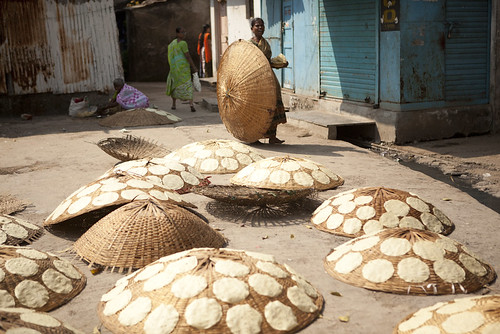 |
| Photo by Caroline Bourdeau |
Today I took a tour of the largest slum in Asia. As an urban economist on a
university-sponsored visit to India, I couldn’t justify not seeing Dharavi in
person. Luckily an NGO called RealityTours has been taking groups through the slum for seven years. They make it very easy to see what otherwise
would be a foreboding part of town. Not
only does Reality Tours run a great tour, but they also run lots of programsfor Dharavi residents, and the tour operation is really a business run by the
NGO to fund their good deeds.
Here I’ll recap the tour. For some amazing photos hosted by the tour operator, click here.
There wasn’t much to see on the car trip to Dharavi from Mumbai city
center, though we did drive through the red light district and also stopped off
at the Dhobi Ghat, a massive outdoor laundry facility that was built by the
British to wash army linens, and is now managed by the Bombay MunicipalCorporation. Our tour guide, Balaji,
provided good information during this trip and the three other tourists with me
were a pleasure to have along.
After about one hour we arrived at Dharavi. In addition to housing more than a million
residents, Dharavi also contains sizeable commercial and industrial
operations. The first stop on the tour
was a recycling facility, which produces a variety of recycled materials, from
plastic pellets and aluminum ingots for manufacturers, where the source
material is collected by rag-pickers and brought to the plant, to cleaning
vegetable oil drums for repackaging (one might say this is technically an
example of re-using rather than recycling.)
Next, we toured a leather factory.
The tanning, which is a highly toxic process, no longer takes place in
Dharavi, but the rest of the process still does (and it all still seems fairly
toxic to me.) Really the recycling facility was quite toxic
as well. I was not that comfortable
being there for just a few minutes, and the conditions that the workers endure
day after day definitely qualifies these facilities as sweat shops in my book.
We saw two other production facilities, but we also stopped in some
schools run by Reality Tours, and a flat they rent to show the tour
groups. The flat was 10 square meters, a
typical sized apartment for Dharavi. It
has running water for three hours a day, and reliable electricity 24/7 (our
guided said Dharavi is a five-star slum!)
However the toilets are all communal and each toilet serves more than a
thousand residents. Five starts perhaps,
but still a slum. The rent for such a
unit is about $60 per month.
As we walked through Dharavi, we took some routes which included the
narrowest alleys I’ve ever seen. We
literally walked through alleys that require single-file lines, while the
sewage is running beneath our feet, covered only by stepping stones. On the other hand, some of the streets we
took were relatively broad, and one in particular had elaborate decorations
overhead in celebration of a festival that took place a day or two before.
The last two industries we saw were the papad producers, who really
just work out of their home rolling and drying papadums in the sun, and the
pottery producers. Of all the four
industries, the papad producers have the least toxic conditions.
 |
| Photo by Ishan Khosla |
Pottery doesn’t seem so bad either, though to fuel
the furnaces that bake the pottery requires burning various types of fuel (I
believe trash is the common source of fuel) and this of course emits toxic
smoke, but if I had to choose, I’d take pottery over plastic recycling (which
runs on coal) or leather processing (which is dirty in a number of other ways.) I suppose stitching together the leather
jackets, purses, etc. doesn’t involve much toxic work per se, but sitting in
front of a sewing machine all day strikes me as excruciatingly boring, so I’d
still take pottery over leather work, if I had to pick.
The residents of Dharavi lead hard lives. The good news is, although the opportunities
they have are not ones you or I would consider good opportunities, they are opportunities
none the less. My grandparents lived
hard lives, having to deal with both Nazis and Bolsheviks, however at the end
of their lives, I like to think that they looked back at their time on earth as
time well spent, as comparatively, their efforts provided their children and
grandchildren with lives of luxury.
Although I know that basically all of the Dharavi residents we saw today
will continue to lead hard lives, I hope that many of them will be able to
provide better futures for their offspring, and will have the satisfaction of
knowing that their lives were well lived too.
photo credits:
http://www.flickr.com/photos/gatesfoundation/6721693949/
http://www.flickr.com/photos/ishanz/6929072285/
photo credits:
http://www.flickr.com/photos/gatesfoundation/6721693949/
http://www.flickr.com/photos/ishanz/6929072285/